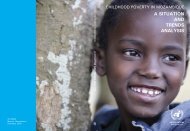Mozambican Civil Society Within: - UNICEF Mozambique - Home page
Mozambican Civil Society Within: - UNICEF Mozambique - Home page
Mozambican Civil Society Within: - UNICEF Mozambique - Home page
Create successful ePaper yourself
Turn your PDF publications into a flip-book with our unique Google optimized e-Paper software.
<strong>Mozambican</strong> <strong>Civil</strong> <strong>Society</strong> <strong>Within</strong>: Evaluation, Challenges, Opportunities and Action<br />
Figure 3.1.3: Perceptions of Geographic<br />
Distribution of CSOs in<br />
<strong>Mozambique</strong>, 2007 (%)<br />
Figure 3.1.4: Distribution of CSOs,<br />
<strong>Mozambique</strong> 2003<br />
(%)<br />
Mainly in big cities<br />
45.3<br />
45<br />
40<br />
35<br />
42.4<br />
33.5<br />
Mainly limited to<br />
urban areas<br />
Everywhere, even<br />
remote areas<br />
19.8<br />
16.9<br />
30<br />
25<br />
20<br />
15<br />
Everywhere except<br />
remote areas<br />
18<br />
0 5 10 15 20 25 30 35 40 45 50<br />
INOSC, 2007<br />
10<br />
5<br />
0<br />
Local<br />
Community<br />
Districts<br />
6.6 6.7<br />
Surrounding<br />
cities<br />
a province<br />
4<br />
various<br />
provinces<br />
5.7<br />
national<br />
1.1<br />
International<br />
cirisFlu 2006<br />
As regards the first aspect, it is generally believed that NGOs predominate among CSOs. Yet of<br />
the roughly 5000 non-profit institutions surveyed by INE (2006), the vast majority are associations<br />
(92%), either religious (53%) or political, advocacy and legal ones (25%) and only 2% are<br />
associations of an educational nature. NGOs account for less than 10%: only 3% are national<br />
NGOs and 4% international NGOs, while foundations represent only 0.4% of CSOs. 11<br />
Consequently, considering the CSO classification used by INE it was concluded that there is<br />
weak diversity of civil society organizations: about 75% belong to two types of organization:<br />
religious and political. There are few organizations for women or minority groups, although<br />
there is, for example, the <strong>Mozambican</strong> Women’s Organisation (OMM) strongly associated with<br />
the party in power, Frelimo that is spread throughout the country. However, the fact that OMM is<br />
strongly linked to one party limits its ability to engage a wide range of women who are not<br />
interested in direct party activities.<br />
3.1.4 Level of organisation<br />
This sub-dimension analyses the coverage of umbrella bodies, their effectiveness and the<br />
organizational self-regulation, support infrastructure and linkages of CSOs in <strong>Mozambique</strong>. How<br />
well organized is civil society? What kind of infrastructure exists for CSOs?<br />
The average score validated by the NAG is 0.6, suggesting that the organizational development<br />
of <strong>Mozambican</strong> civil society is weak. Table 3.1.4 details the scores of the respective indicators.<br />
11<br />
INE also identified 12% of CSOs in a group of “others”, comprising a number of very small organizations involved in a variety of activities<br />
34<br />
<strong>Civil</strong> <strong>Society</strong> Index, <strong>Mozambique</strong> 2007
















